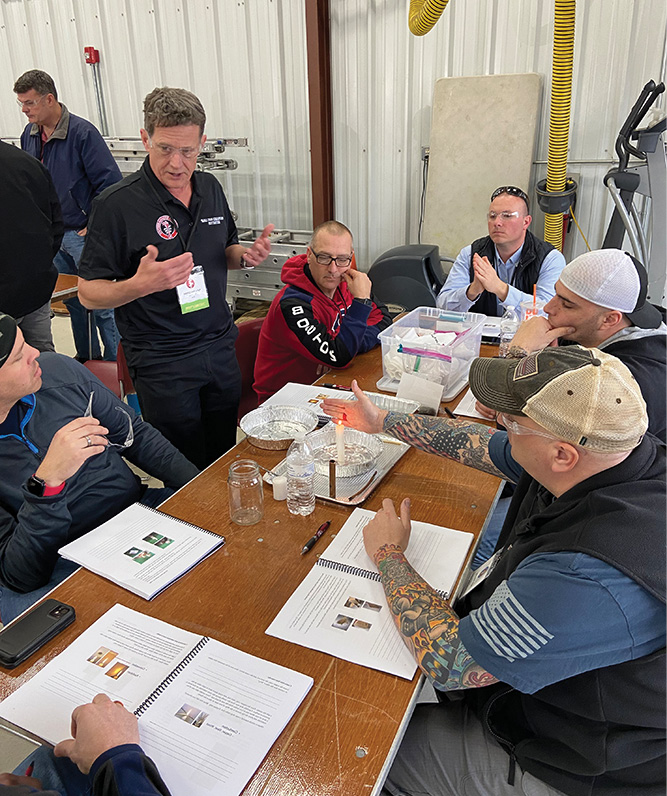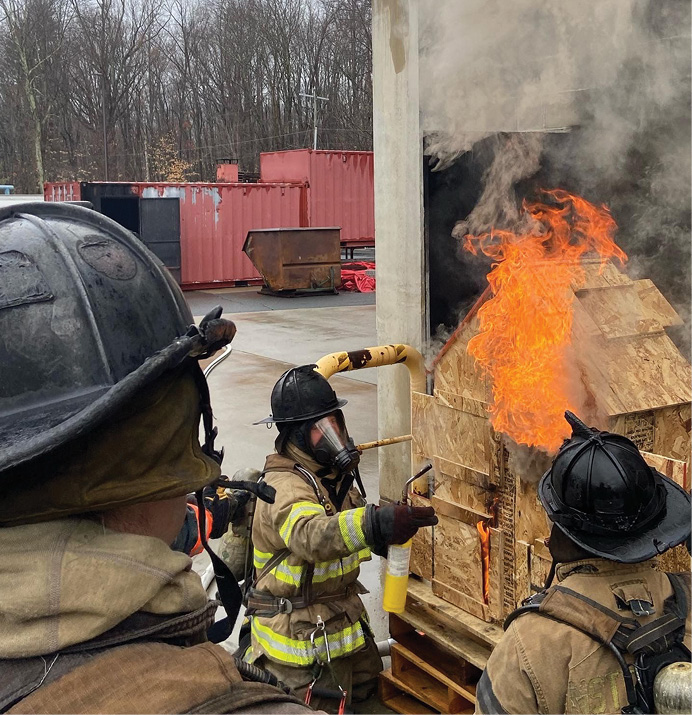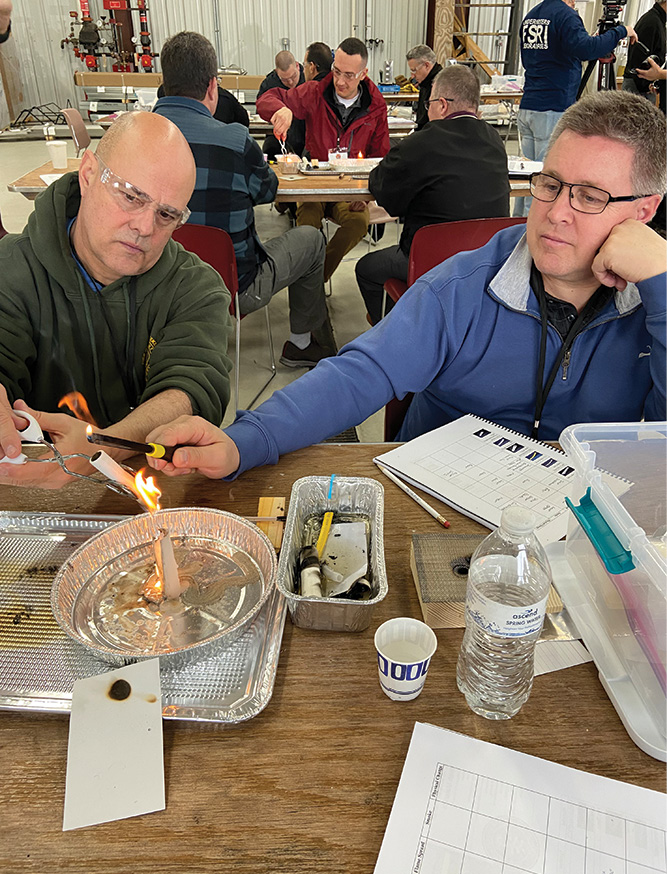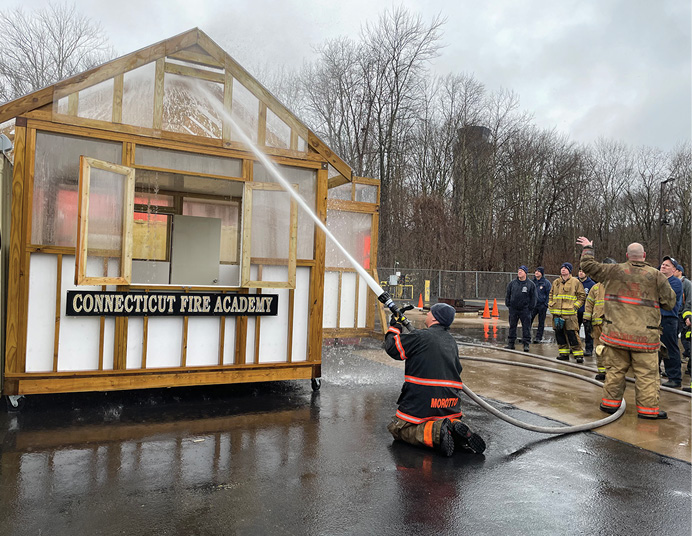BY P.J. NORWOOD AND BRIAN H. HURST
On July 1, 2013, UL FSRI published the Study of the Effectiveness of Fire Service Vertical Ventilation and Suppression Tactics in Single-Family Homes. The release of this study started the reshaping of the 21st century fire service. Here’s a look at what led up to its development and why research-based tactics are so important today.
1903 Tragedy
In late 1903, a fire engulfed Chicago’s Iroquois Theatre. The fire killed more than 600 people—mainly women and children. Underwriters Laboratories (UL) assisted in the investigation by hosting a series of tests on “fireproof” curtains and sharing research on “fireproof” paints. But, if only the theater’s fire extinguisher had worked, this tragedy might have been lessened. UL’s founder, Henry Merrill Jr., set out to help improve the outcomes of future fires.
- Applying Science to Tactics: One Year Later
- Today’s Evolving Fire Attack
- Unlocking the Secrets of Fire Behavior: A Vital Evolution in Firefighting Tactics
A Groundbreaking Study
The 2013 release of the vertical ventilation study was the first challenge to traditional tactics, years of information and education, and generations of experience and knowledge. The first few years after its release saw many spirited debates and some lines drawn in the sand. Passionate firefighters, officers, and instructors argued on each side, and many found themselves caught in the middle. And now we know this was also the start of a rapid acceleration of the adoption of research-based tactics.
Today, research-based tactics are part of policy, textbooks, consensus standards, and defined best practices. We have also seen many case studies where property and lives benefited from utilization of research-based tactical considerations. We have reached a point where the information and education from the research must be incorporated into state fire academies, recruit schools, and all entry-level training. If we are not educating our newest members about the research and adapting our approaches in both the classroom and the training ground, then we are setting these new firefighters up for failure and doing a disservice to the communities they serve.
Many fire departments struggle to figure out how to best incorporate this information into their programs. The Connecticut Fire Academy (CFA) has worked diligently to ensure all Connecticut firefighters have access to and receive the most up-to-date training and education available.
March 2022: The First Boot Camp
The CFA began its implementation in March 2022 by hosting a UL FSRI Fire Dynamics Boot Camp, with 16 instructors. This boot camp drew 50 attendees from many New England states (photo 1). Attendees received three full days and nights of education, networking, and learning through formal classroom sessions, hands-on sessions, and roundtable discussions. These sessions all led to a new understanding of the research as well as tactical considerations. And for many, they answered the “why.”

1. The CT Fire Academy received training from UL FSRI that included national industry experts, including Training Chief (Ret.) Peter Van Dorpe, Chicago (IL) Fire Department. (Photos by P.J. Norwood.)
Attendees also benefited from a presentation of true heroism from Steve Captain DesRuisseaux, Manchester (NH) Fire Department. “As I was making the second-floor rescues, that’s when everything lit up,” he said. “Conditions deteriorated rapidly. As I was trying to make it out the window, I dove on the ladder and my gear got hung up, with my airpack at the top of the ladder. I was involved in direct fire for about 30 seconds.”
These three days changed the landscape for education, training, and deployment of tactics on the fireground. The CFA faced a new challenge: As an organization, it had to figure out how to put this information into action for the fire service.
Instructor Development
The first boot camp revealed the importance of instructor development. In addition to the 16 instructors at the training, more than 200 teach for the academy. Just because the instructors were present did not mean they were ready to start teaching this new information. We recognized the importance of developing our instructors and not launching information they weren’t ready to deliver.
Captain Mike Eremita, from the Hartford (CT) Fire Department, took an interest. He began diving into the resources FSRI supplied to the CFA.
Eremita also used the resources to create a CFA Fire Dynamics curriculum. This curriculum is still a work in progress as we continue to define what information every level of student needs. The information provided to students in a recruit program differs from what students in a fire officer program need.
Simultaneously, Captain Peter Morotto, a CFA recruit coordinator and live fire instructor from the Bridgeport (CT) Fire Department, along with (co-author of this article) Brian Hurst, a CFA recruit firefighter program and live fire program manager, began working to develop the hands-on stations. This included several steps:
- Defining the stations.
- Obtaining the necessary supplies.
- Working with logistics to build and obtain props for the various hands-on educational stations.
For the next step, we had to address the cognitive education and hands-on stations within our recruit firefighter program. The program manager and coordinators began reshaping the program to include fire dynamics information and application.
The program has prided itself on preparing the graduates as jump-seat-ready firefighters but recognized that new approaches were needed to train its recruits. For the past three classes, the program has used interactive lectures from its publisher’s learning management system to provide the necessary cognitive information. New in-person presentations and skills are now available to help students focus more on the application of modern fire dynamics to the related firefighting subjects. Company operations and live fire training evolutions now include fire dynamics tactics.
While revising the recruit curriculum, we needed to ensure the objectives of National Fire Protection Association (NFPA) 1001 (now NFPA 1010) were being met. During our research, we also found critical fire dynamics-related requirements in NFPA 1403 not usually associated with entry-level training. NFPA 1403 has fire dynamic prerequisite training that must be met before performing live fire training evolutions. By adjusting our practical skills training objectives and reference materials, we were able to meet both standards.
Firefighting tasks including forcible entry, search, ventilation, and fire attack have been enhanced to cover fire dynamics-influenced job performance requirements. Each practical skills section happens over three consecutive days. This provides the academy with an opportunity to develop and adjust each skill station to the new curriculum. The recruit program also has three days of company operations and three additional days of live fire training for adapting new researched-based tactics and communications.
The academy effectively uses the recruit firefighter program to vet its new fire dynamics-based lessons and to ensure the quality and delivery of off-campus classes. New classes enhance off-campus training to accommodate the drill schedules and weekend offerings for volunteer and career departments.
The first time we delivered this curriculum, to Recruit Class 70, it was a success—not only for the recruits but also for the academy. A big takeaway was the realization that we needed a bigger group of instructors. As a result, we created and held the first two-day instructor development class. This class provided an overview of the classroom curriculum and included a hands-on session to offer extensive education of the following stations: Palmer’s dollhouse (photo 2), alcohol prop, alcohol-fueled flow path prop (photo 3), candle and pressure lab (photos 4 & 5), water mapping prop (photo 6), and live fire within the flashover simulator.
Curriculum Progress
We created a comprehensive, hands-on education guide, which includes everything instructors need to deliver these hands-on stations:
- An overview of each station.
- Supplies for the actual lessons and the educational points.
- Content that covers the foundation, for consistency in our delivery model.
Shortly after this successful delivery, CT fire departments began requesting different deliveries of our fire dynamics program. Here’s an idea of what departments asked about:
- Specific educational items, such as a flow path class using the alcohol prop and Palmer’s dollhouse.
- Fully immersed, two- and three-day program for every member of their department.
- Train-the-trainer programs for training staff.
In the winter of 2023, as we began preparations for Recruit Class 71 (fall 2023), the program manager dove back into the program and began to redefine the ways to deliver this information to future programs.
Academy Development
Looking ahead, the program will include additional two-day instructor development programs, with the main goal of getting all of our officers, recruits, and live fire instructors up to speed with the rest of the cadre. We plan to hire additional instructors and to expand instructor orientation from one day to three days. This will include the two-day fire dynamics program for newly hired instructors. It’s critical that we educate our new staff up front and that we continue to develop our instructors.
The logistics staff looks forward to presenting an all-new NFPA 1403-compliant, live fire training prop within a Conex box. This first training prop will feature a forcible entry door, hoseline stretch area with diminishing clearance, multiple pinch points, and an interior burn room with a door (to focus on door control). The recruit program will use this box for thermal imaging, can confidence, hoseline management, and interior water application. Future props will include a truck company-specific live fire Conex box.

2. Using a “Palmer’s House” small-scale, live-fire prop, students have the opportunity to learn how fire reacts to the environment and they cover ventilation tactics.

3. CT Fire Academy instructors use small-scale, live-fire training props to enhance and further firefighter education.

4. Through interactive lessons, students learn the theory in the classroom and then experience the science in hands-on lessons that are carried over to the fireground. Here, two instructors demonstrate how the Bernoulli principle applies to the fireground.

5. Fire is physics, and incorporating small-scale lessons with candles helps firefighters understand and apply appropriate tactical decisions on the fireground.

6. Firefighters use a new UL FSRI water-mapping prop to learn how fire streams can impact the environment.
Recommended Approach
While many of these lessons could be completed in a traditional flashover simulator, the content is better delivered and practiced in a live fire box that’s on plane. The CFA will still use the flashover simulator as it was traditionally built but for lessons that enhance the new understanding of ventilation-limited fires and the impact of ventilation.
The CFA has embraced research-based tactics and modernized firefighting education. These accomplishments are a testament to the staff’s dedication to the safety and proficiency of the firefighters who complete our programs.
Through rigorous training, hands-on sessions, and continuous development, the CFA has successfully integrated fire dynamics principles into the curriculum. The commitment to instructor development, coupled with the construction of innovative NFPA 1403-compliant live fire training props, showcases the academy’s progressive approach. By embracing change, adapting teaching methodologies, and fostering a culture of continuous learning, the CFA is not only shaping the future of firefighting education but also ensuring that every firefighter is equipped with the knowledge and skills needed to face the challenges of modern fire service. The staff’s efforts serve as an inspiring example, emphasizing the crucial role of research-based education in safeguarding both the firefighters and the communities they serve.
REFERENCES
“Lessons Learned from Chicago’s Tragic Iroquois Theatre Fire,” UL Research Institutes, April 5, 2022. bit.ly/3wtVRxh.
Study of the Effectiveness of Fire Service Vertical Ventilation and Suppression Tactics in Single-Family Homes, Fire Safety Research Institute, June 15, 2013. bit.ly/49Md6Ij.
P.J. NORWOOD is the director of training for the Connecticut Fire Academy. He is a retired deputy chief from the East Haven (CT) Fire Department. He is on the Fire Engineering/FDIC Advisory Board and has many roles within UL FSRI, including technical panel member, fire dynamics instructor, and training advisory committee member. He is also a member of the First Responder Center for Excellence Cancer Alliance.
BRIAN H. HURST has 33 years of fire service experience as a member of the Watertown (CT) Fire Department. He served 25 years with the Manchester (CT) Fire Department before retiring in 2022 as a battalion chief/shift commander. He also has 25 years of experience as a fire instructor, with more than 20 years at the Connecticut Fire Academy, where he is currently the manager of the Recruit Firefighter Program.

